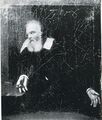Template:Selected anniversaries/August 25: Difference between revisions
No edit summary |
No edit summary |
||
| Line 1: | Line 1: | ||
<gallery> | <gallery> | ||
||1561 | ||1561: Philippe van Lansberge born ... astronomer and mathematician. | ||
File:Galileo E pur si muove.jpg|link=Galileo Galilei (nonfiction)|1609: [[Galileo Galilei (nonfiction)|Galileo Galilei]] demonstrates his first telescope to Venetian lawmakers. | File:Galileo E pur si muove.jpg|link=Galileo Galilei (nonfiction)|1609: [[Galileo Galilei (nonfiction)|Galileo Galilei]] demonstrates his first telescope to Venetian lawmakers. | ||
| Line 8: | Line 8: | ||
File:Charles Camus - Cours de mathématique.jpg|link=Charles Étienne Louis Camus (nonfiction)|1699: Mathematician and mechanician [[Charles Étienne Louis Camus (nonfiction)|Charles Étienne Louis Camus]] born. He will be the author of ''Cours de mathématiques'' (Paris, 1766), along with a number of essays on mathematical and mechanical subjects. | File:Charles Camus - Cours de mathématique.jpg|link=Charles Étienne Louis Camus (nonfiction)|1699: Mathematician and mechanician [[Charles Étienne Louis Camus (nonfiction)|Charles Étienne Louis Camus]] born. He will be the author of ''Cours de mathématiques'' (Paris, 1766), along with a number of essays on mathematical and mechanical subjects. | ||
||1812 | ||1812: Nikolay Zinin born ... organic chemist. Pic: Extreme Moustache! | ||
File:Clock Head (da Vinci version).jpg|link=Clock Head|1818: Mechanical soldier [[Clock Head]] receives several patents for an improvements to steam engines. | File:Clock Head (da Vinci version).jpg|link=Clock Head|1818: Mechanical soldier [[Clock Head]] receives several patents for an improvements to steam engines. | ||
| Line 14: | Line 14: | ||
File:James Watt.jpg|link=James Watt (nonfiction)|1819: inventor, engineer, and chemist [[James Watt (nonfiction)|James Watt]] dies. He made major improvements to the steam engine. | File:James Watt.jpg|link=James Watt (nonfiction)|1819: inventor, engineer, and chemist [[James Watt (nonfiction)|James Watt]] dies. He made major improvements to the steam engine. | ||
||1822 | ||1822: William Herschel dies ... astronomer and composer. | ||
||1835 | ||1835: The first Great Moon Hoax article is published in The New York Sun, announcing the discovery of life and civilization on the Moon. | ||
||1844: Thomas Muir ... mathematician, remembered as an authority on determinants. Pic: https://commons.wikimedia.org/wiki/File:Thomas_Muir_Mathematician.jpg | ||1844: Thomas Muir born ... mathematician, remembered as an authority on determinants. Pic: https://commons.wikimedia.org/wiki/File:Thomas_Muir_Mathematician.jpg | ||
||1865: The Shergotty meteorite falls. It is the first example of the shergottite Mars meteorite family. It was a 5-kilogram (11 lb) Martian meteorite which fell to Earth at Shergotty (now Sherghati), in the Gaya district, Bihar, India on 25 August 1865, and was retrieved by witnesses almost immediately. Radiometric dating indicates that it solidified from a volcanic magma about 4.1 billion years ago. It is composed mostly of pyroxene and is thought to have undergone preterrestrial aqueous alteration for several centuries. Certain features within its interior are suggestive of being remnants of biofilm and their associated microbial communities. | ||1865: The Shergotty meteorite falls. It is the first example of the shergottite Mars meteorite family. It was a 5-kilogram (11 lb) Martian meteorite which fell to Earth at Shergotty (now Sherghati), in the Gaya district, Bihar, India on 25 August 1865, and was retrieved by witnesses almost immediately. Radiometric dating indicates that it solidified from a volcanic magma about 4.1 billion years ago. It is composed mostly of pyroxene and is thought to have undergone preterrestrial aqueous alteration for several centuries. Certain features within its interior are suggestive of being remnants of biofilm and their associated microbial communities. | ||
||1867 | ||1867: Michael Faraday, English physicist and chemist dies ... contributed to the study of electromagnetism and electrochemistry. His main discoveries include the principles underlying electromagnetic induction, diamagnetism and electrolysis. | ||
||1841 | ||1841: Emil Theodor Kocher born ... physician and academic, Nobel Prize laureate. | ||
||1894 | ||1894: Kitasato Shibasaburō discovers the infectious agent of the bubonic plague and publishes his findings in The Lancet. | ||
||1898 | ||1898: Helmut Hasse born ... mathematician and academic. | ||
||1900 | ||1900: Hans Adolf Krebs born ... physician and biochemist, Nobel Prize laureate ... pioneer scientist in study of cellular respiration, a biochemical pathway in cells for production of energy. He is best known for his discoveries of two important chemical reactions in the body, namely the urea cycle and the citric acid cycle. The latter, the key sequence of metabolic reactions that produces energy in cells, often eponymously known as the "Krebs cycle", earned him a Nobel Prize in Physiology or Medicine in 1953. Pic. | ||
||1908 | ||1908: Henri Becquerel dies ... physicist and chemist, Nobel Prize laureate. | ||
||1913 | ||1913: Walt Kelly born ... illustrator and animator. | ||
||Tosio Kato | ||1917: Tosio Kato born ... mathematician who worked with partial differential equations, mathematical physics and functional analysis. Pic. | ||
File:Clock Head 2.jpg|link=Clock Head 2|1933: [[Clock Head 2]] publishes new class of [[Gnomon algorithm functions]] which detect and prevent [[crimes against mathematical constants]]. | File:Clock Head 2.jpg|link=Clock Head 2|1933: [[Clock Head 2]] publishes new class of [[Gnomon algorithm functions]] which detect and prevent [[crimes against mathematical constants]]. | ||
| Line 42: | Line 42: | ||
File:Philo T Farnsworth.jpg|link=Philo Farnsworth (nonfiction)|1934: Inventor [[Philo Farnsworth (nonfiction)|Philo Farnsworth]] demonstrates his electronic television system to the public at the Franklin Institute in Philadelphia. | File:Philo T Farnsworth.jpg|link=Philo Farnsworth (nonfiction)|1934: Inventor [[Philo Farnsworth (nonfiction)|Philo Farnsworth]] demonstrates his electronic television system to the public at the Franklin Institute in Philadelphia. | ||
||1948 | File:Chairman Dies of House Committee investigating Un-American activities.jpg|link=House Un-American Activities Committee (nonfiction)|1948: The [[House Un-American Activities Committee (nonfiction)|House Un-American Activities Committee holds]] first-ever televised congressional hearing: "Confrontation Day" between Whittaker Chambers and Alger Hiss. | ||
||Hedley Ralph Marston | ||1965: Hedley Ralph Marston dies ... biochemist ... In the 1950s, Marston's research into fallout from the British nuclear tests at Maralinga brought Marston into bitter conflict with the government appointed Atomic Weapons Tests Safety Committee. He was vindicated posthumously by the McClelland Royal Commission, which found that significant radiation hazards existed at many of the Maralinga test sites long after the tests. Pic. | ||
||John Ray Dunning | ||1975: John Ray Dunning dies ... physicist who played key roles in the Manhattan Project that developed the first atomic bombs. He specialized in neutron physics, and did pioneering work in gaseous diffusion for isotope separation. | ||
||1981 | ||1981: Voyager 2 spacecraft makes its closest approach to Saturn. | ||
||Milton Stanley Livingston | ||1986: Milton Stanley Livingston dies ... accelerator physicist, co-inventor of the cyclotron with Ernest Lawrence, and co-discoverer with Ernest Courant and Hartland Snyder of the strong focusing principle, which allowed development of modern large-scale particle accelerators. | ||
||Jean-Louis Verdier | ||1989: Jean-Louis Verdier dies ... mathematician who worked, under the guidance of Alexander Grothendieck, on derived categories and Verdier duality. Pic. | ||
||1989 | ||1989: The Voyager 2 spacecraft makes its closest approach to Neptune and provided definitive proof of the existence of the planet's rings. | ||
||1991 | ||1991: Linus Torvalds announces the first version of what will become Linux. | ||
||Ruth Aaronson Bari | ||2005: Ruth Aaronson Bari dies ... mathematician known for her work in graph theory and algebraic homomorphisms. Pic. | ||
File:Voyager spacecraft diagram.png|link=Voyager 1 (nonfiction)|2012: [[Voyager 1 (nonfiction)|Voyager 1]] crossed the heliopause to become the first spacecraft to enter interstellar space and study the interstellar medium. | File:Voyager spacecraft diagram.png|link=Voyager 1 (nonfiction)|2012: [[Voyager 1 (nonfiction)|Voyager 1]] crossed the heliopause to become the first spacecraft to enter interstellar space and study the interstellar medium. | ||
| Line 64: | Line 64: | ||
File:George Spencer-Browne.jpg|link=George Spencer-Brown (nonfiction)|2016: Polymath [[George Spencer-Brown (nonfiction)|George Spencer-Brown]] dies. He wrote ''Laws of Form'', calling it the "primary algebra" and the "calculus of indications". | File:George Spencer-Browne.jpg|link=George Spencer-Brown (nonfiction)|2016: Polymath [[George Spencer-Brown (nonfiction)|George Spencer-Brown]] dies. He wrote ''Laws of Form'', calling it the "primary algebra" and the "calculus of indications". | ||
||James Watson Cronin | ||2016: James Watson Cronin dies ... particle physicist. Pic. | ||
File:The Eel Time-Surfing 2.jpg|link=The Eel Time-Surfing 2|2017: Signed first edition of ''[[The Eel Time-Surfing 2]]'' sells for two and a half million dollars. | File:The Eel Time-Surfing 2.jpg|link=The Eel Time-Surfing 2|2017: Signed first edition of ''[[The Eel Time-Surfing 2]]'' sells for two and a half million dollars. | ||
</gallery> | </gallery> | ||
Revision as of 12:19, 19 August 2018
1609: Galileo Galilei demonstrates his first telescope to Venetian lawmakers.
1698: Physicist, mathematician, and inventor Denis Papin demonstrates new version of his steam digester which uses Gnomon algorithm principles to generate gray light and cryptographic numina.
1699: Mathematician and mechanician Charles Étienne Louis Camus born. He will be the author of Cours de mathématiques (Paris, 1766), along with a number of essays on mathematical and mechanical subjects.
1818: Mechanical soldier Clock Head receives several patents for an improvements to steam engines.
1819: inventor, engineer, and chemist James Watt dies. He made major improvements to the steam engine.
1933: Clock Head 2 publishes new class of Gnomon algorithm functions which detect and prevent crimes against mathematical constants.
1934: Inventor Philo Farnsworth demonstrates his electronic television system to the public at the Franklin Institute in Philadelphia.
1948: The House Un-American Activities Committee holds first-ever televised congressional hearing: "Confrontation Day" between Whittaker Chambers and Alger Hiss.
2012: Voyager 1 crossed the heliopause to become the first spacecraft to enter interstellar space and study the interstellar medium.
2016: Polymath George Spencer-Brown dies. He wrote Laws of Form, calling it the "primary algebra" and the "calculus of indications".
2017: Signed first edition of The Eel Time-Surfing 2 sells for two and a half million dollars.










